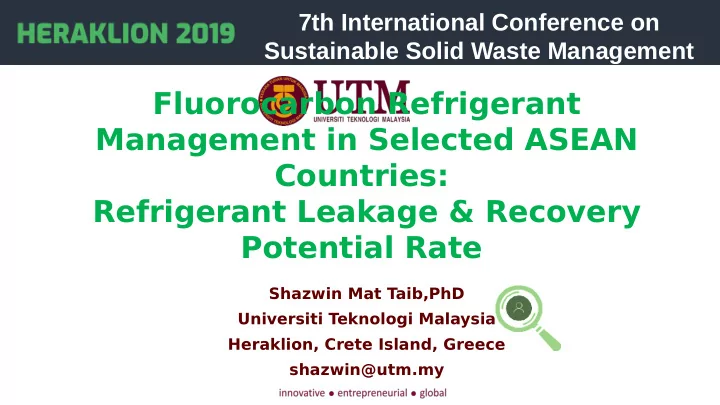

7th International Conference on Sustainable Solid Waste Management Fluorocarbon Refrigerant Management in Selected ASEAN Countries: Refrigerant Leakage & Recovery Potential Rate Shazwin Mat Taib,PhD Universiti Teknologi Malaysia Heraklion, Crete Island, Greece shazwin@utm.my
Environmental Sound Management of Fluorocarbon (FC) Refrigerant Fluorocarbons (CFCs, The demand of air HCFC,HFCs) are used as conditioning and refrigerant refrigerant for temperature is increasing as the world exchange equipment warms and as wealth ( Example: Refrigeration units, food increases showcases, unit coolers, air Room AC Demand conditioner, chiller etc) Country Refrigerant (thousand units) 2010 2015 World Total 73,420 79,389 R-22 dominant (Other Asia Total) Malaysia 751 789 R-22 dominant, R-32 (starting) Indonesia 1493 2109 R-22, R-410A, R-32 (~33%) Thailand 957 1268 R-22, R-32 (~50%) Vietnam 670 1546 R-22 (~60%), R-32 (~20%) Market using HFCs, % of tonnes CO 2 e in 2012 Details of room AC demand and refrigerant used in 2015 (UNEP Ozone Secretariat . , 2015) (Shah et al., 2017)
Fluorocarbon (FC) Refrigerant 2 nd Generation Ultraviolet 4 th Generation Hydrochlorofmuorocarbon Hydrocarbon (HC); Ozone hole Ozone layer (HCFC) Hydrofmuoroolefjn (HFO) • R-22, R123 • NO Ozone Depleting • STOP import 2020 Potential CFCs • T otally ban 2040 HC HCFC Ozone Global HFO Depletion Warming HFC CFC 3 rd Generation 1 st Generation Hydrofmuorocarbon (HFC) Chlorofmuorocarbon • R-32, R-134s, R-410a (CFC) • Low Ozone Depleting • R-11, R-12, R-500 Substances • Invented in 1920s Montreal • High Global Warming Potential • Ban from 2010 Protocol • Control under Kigali (January, 1989) Amendment 2016
Focus Group Discussion Reclamation, Capacity Building for Used Fluorocarbon Common Issues & Manufacturing & Awareness & Management Shareable Measures Consumption Trend Implementation 2013 2016 2018 2014 2015 2017 2019 Energy Saving Equipment & Energy Conservation Leakage Prevention Using Sound Fluorocarbon Diagnosis IoT for Energy Saving & Management & End Of Life survey GHG Emission Reduction
Case Study 1 : Cross Country Analysis in Southeast Asia Indonesia, Malaysia, Thailand and Vietnam Government (19 Associations/Institutes departments/offjces) (14 entities) National ozone units and Equipment their supervisory manufacturers, authorities, energy servicing/maintenance effjciency-related technicians, waste departments, waste operators, green Private companies (11 regulators, standards buildings Academia (8 companies) department, training universities) Equipment institute Specialists in policies manufacturers, gas and technologies for traders, waste handlers, refrigerants and recycling and Others wastes transportation UNEP, UNDP, JICA etc companies, FCs destruction (industrial
Case Study 1 : Common Issues Indonesia, Malaysia, Thailand & Vietnam Low o Not aware of the importance of proper awareness treatment of FCs level with no o Not aware energy saving potential from regulation leakage control imposed o All 4 countries have no regulation to Only 1 gas destruction facility in each mandate FCs recovery from used equipment Lack fjnancial country hence high cost for destruction and support transportation cost Not clear who pays for collection and The Montreal Protocols fund not covering No proper transportation cost installation cost for destruction facility treatment and Managing and monitoring collection and disposal proper treatment of FCs become challenging facilities due to presence of informal sector Less cross Few cross ministerial/ department ministerial discussions have been realized on the issue among of the proper treatment of FCs regulators Example: DOE Air Division, Waste-related
Case Study 2: UTM in Campus Recovery Potential Rate LANDFILL N Reclaimed Amount Amount o 1 Transported weight (kg) 311.5 2 Processed weight (kg) 202.0 3 Final net weight (kg) 160.0 T otal percentages loss (%) 20.79 Recoverable R-123 (HCFC) 79.21 (%) Reclaimed amount and percentage loss
Case Study 2: UTM in Campus Warming Impact and Leakage Rate Total Equivalent Warming Impact (TEWI) in campus
Way Forward
Way Forward: Fluorocarbon Gas Leakage Monitoring By Using IoT For Energy Saving Co- benefjt
THANK YOU
Recommend
More recommend